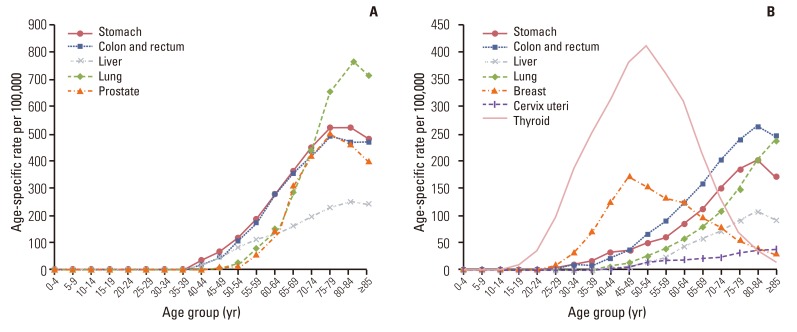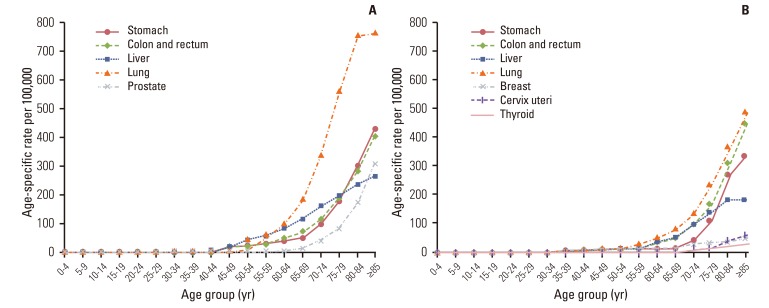Cancer Res Treat.
2014 Apr;46(2):124-130.
Prediction of Cancer Incidence and Mortality in Korea, 2014
- Affiliations
-
- 1The Korea Central Cancer Registry, National Cancer Center, Goyang, Korea. astra67@ncc.re.kr
- 2National Cancer Control Institute, National Cancer Center, Goyang, Korea.
Abstract
- PURPOSE
We studied and reported on cancer incidence and mortality rates as projected for the year 2014 in order to estimate Korea's current cancer burden.
MATERIALS AND METHODS
Cancer incidence data from 1999 to 2011 were obtained from the Korea National Cancer Incidence Database, and cancer mortality data from 1993 to 2012 were acquired from Statistics Korea. Cancer incidence in 2014 was projected by fitting a linear regression model to observed age-specific cancer incidence rates against observed years, then multiplying the projected age-specific rates by the age-specific population. For cancer mortality, a similar procedure was employed, except that a Joinpoint regression model was used to determine at which year the linear trend changed significantly.
RESULTS
A total of 265,813 new cancer cases and 74,981 cancer deaths are expected to occur in Korea in 2014. Further, the crude incidence rate per 100,000 of all sites combined will likely reach 524.7 and the age-standardized incidence rate, 338.5. Meanwhile, the crude mortality rate of all sites combined and age-standardized rate are projected to be 148.0 and 84.6, respectively. Given the rapid rise in prostate cancer cases, it is anticipated to be the fourth most frequently occurring cancer site in men for the first time.
CONCLUSION
Cancer has become the most prominent public health concern in Korea, and as the population ages, the nation's cancer burden will continue to increase.
MeSH Terms
Figure
Reference
-
1. Statistics Korea [Internet]. Daejeon: Statistics Korea;2014. cited 2014 Jan 24. Available from: http://kosis.kr.2. Jung KW, Won YJ, Kong HJ, Oh CM, Seo HG, Lee JS. Cancer statistics in Korea: incidence, mortality, survival and prevalence in 2010. Cancer Res Treat. 2013; 45:1–14. PMID: 23613665.
Article3. Shin HR, Won YJ, Jung KW, Kong HJ, Yim SH, Lee JK, et al. Nationwide cancer incidence in Korea, 1999~2001: first result using the National Cancer Incidence Database. Cancer Res Treat. 2005; 37:325–331. PMID: 19956367.
Article4. Fritz A, Percy C, Jack A, Shanmugaratnam K, Sobin L, Parkin DM, et al. International classification of diseases for oncology. 3rd ed. Geneva: World Health Organization;2000.5. World Health Organization. International statistical classification of diseases and related health problems. 10th rev. Geneva: World Health Organization;1994.6. Boyle P, Parkin DM. Statistical methods for registries. In : Jensen OM, Parkin DM, MacLennan R, Muir CS, Skeet RG, editors. Cancer registration: principles and methods. IARC Scientific Publication No. 95. Lyon: IARC Press;1991. p. 126–158.7. National Cancer Institute. Joinpoint regression program, version 4.0 [Internet]. Bethesda: National Cancer Institute;2014. cited 2014 Jan 8. Available from: http://surveillance.cancer.gov/joinpoint/.8. Segi M. Cancer mortality for selected sites in 24 countries (1950-1957). Sendai: Tohoku University School of Medicine;1960.
- Full Text Links
- Actions
-
Cited
- CITED
-
- Close
- Share
- Similar articles
-
- Cancer Statistics in Korea: Incidence, Mortality, Survival, and Prevalence in 2014
- Prediction of Cancer Incidence and Mortality in Korea, 2012
- Prediction of Cancer Incidence and Mortality in Korea, 2011
- Prediction of Cancer Incidence and Mortality in Korea, 2017
- Prediction of Cancer Incidence and Mortality in Korea, 2025




